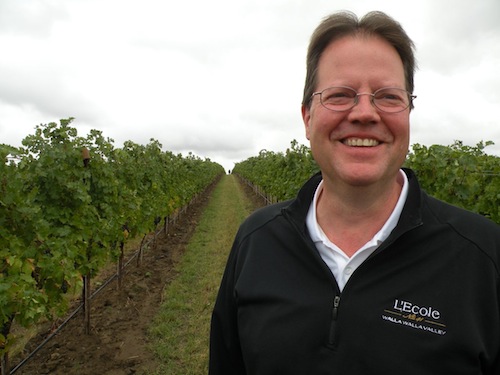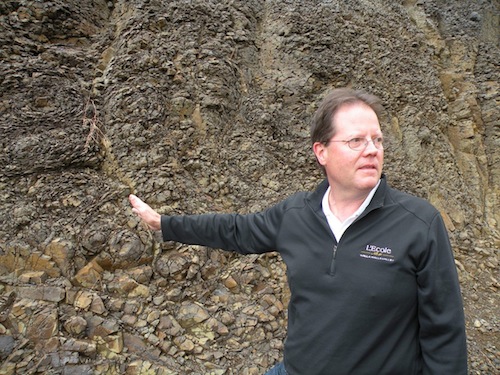
MILTON-FREEWATER, Ore. – Marty Clubb thinks he has come upon a perfect place to grow wine grapes in the Walla Walla Valley.
Along with several other luminaries, the owner of L’Ecole No. 41 is heavily invested in SeVein, a group of high-elevation vineyards on the Oregon side of the Walla Walla Valley. They include Norm McKibben (Pepper Bridge Winery), Gary and Chris Figgins (Leonetti Cellar) and Bob Rupar (Nelson Irrigation).
Additionally, retired NFL and Washington State University star Drew Bledsoe has planted grapes for his Doubleback winery, and JM Cellars, Middleton Family Wines, Va Piano Vineyards, Tendril Wine Cellars, Caprio Cellars and Gramercy Cellars also have bought in. And Premiere Columbia Properties, which owns Pepper Bridge Vineyard and is part of Westchester Agriculture Asset Management – a global ag investment firm – has a significant share of SeVein.
Clubb’s vineyard at SeVein is called Ferguson, named for Jean and Baker Ferguson, his in-laws, who founded L’Ecole No. 41 some 30 years ago in the Walla Walla Valley town of Lowden, Wash.
“It will be our crème de la crème,” Clubb said of Ferguson. “It will take a few years because of the youthful vines, but for the wines to have this dimension this young is enormously promising.”
Clubb owns 42 acres at SeVein, 18 of which are planted so far to Cabernet Sauvignon, Merlot, Malbec, Cabernet Franc and a bit of Syrah. As he continues to plant Ferguson, he estimates 95 percent of it will be to red Bordeaux varieties.
“That’s our strength and our focus at L’Ecole,” Clubb told Great Northwest Wine.
The crown jewel of SeVein has been venerable Seven Hills Vineyard, which was first planted in 1980. McKibben purchased the vineyard in 1994, then partnered with Gary Figgins, Clubb and Rupar to expand it to more than 200 acres.
“It’s the anchoring property for SeVein,” Clubb said. “It’s the identity.”
From wheat to grapes at SeVein
[youtube id=”POT0mYvR2rI” width=”620″ height=”360″]
The property for SeVein once was dryland-farmed wheat fields owned by Mormon families. The Seven Hills partners were salivating at the opportunity to use it for wine grapes but feared they might never get that chance because of the religious aspect of the ownership. However, the property came up for sale in 2004, and the Seven Hills group used a third party to make a blind cash offer for the land, and the sale went through.
The key to the SeVein properties is elevation. Compared with much of the rest of the vast Columbia Valley, the Walla Walla Valley is relatively cool and wet because air and clouds are stopped by the Blue Mountains. This year, for example, the Walla Walla Valley has received 9.3 inches of rain so far, compared with 4 inches on Red Mountain and the Wahluke Slope and just 2.4 inches in the Ancient Lakes near Quincy.
Because of this, Walla Walla is more prone to weather events that can damage vines. To mitigate this, grape growers prefer to plant vineyards on slopes at higher elevations – exactly what SeVein offers. The lowest elevation there is 850 feet at the bottom of Seven Hills, while the highest point is at the top of Ferguson – 1,480 feet. At that height, cool air will slide down the hill and settle on the valley floor, away from the tender vines. This spot might be the area least prone to frost and freeze damage in the entire Walla Walla Valley.
SeVein geology exciting, fascinating

Additionally, the soils are fascinating at SeVein. While most of the Columbia Valley is on top of basalt bedrock from lava flows some 15 million years ago, SeVein is on fractured basalt that allows vines to work their way down. Near the bottom of the property at Seven Hills, wind-blown loess soil – which is sandy – sits atop silts left by the Ice Age floods about 15,000 years ago. But the upper reaches of SeVein are above the height of the floods, and just a thin layer of soil sits atop the fractured basalt.
This is dramatically evident in an area of Ferguson that was excavated to provide gravel for roads. A high wall shows how the ancient basalt formed and fractured, with the thin layer of topsoil above it.
In addition to Ferguson, several other vineyards already have been planted at SeVein – about 400 acres so far. They include Serra Pedace (owned by Leonetti Cellar), Bob Healy (Doubleback), Southwind (Cadaretta), Homeward Bound (Rupar), Margaret’s (JM Cellars) and Summit View (Premiere Columbia Properties).
The total area for SeVein is 2,700 acres, and there is enough water to plant 1,527 acres. This would effectively double the vineyard acreage in the viticulturally small Walla Walla Valley. By comparison, Goose Ridge Vineyard about 60 miles to the west near Red Mountain is 1,600 acres in size.
Clubb works with grapes from nearly every American Viticultural Area in the state, but the soul of his wines comes from the Walla Walla Valley. He brings in a lot of grapes from Seven Hills, and he was the first winery to use fruit from Pepper Bridge. He sees Ferguson as the third leg of his Walla Walla Valley program.
“And not only our third leg, but our strongest leg,” he said.
He recalls the awkward adolescent period of grapes coming from young Seven Hills and Pepper Bridge vines, and he does not see the same issues at Ferguson. While some of this comes from improved viticultural practices, a lot has to do with location and the unusual aspect of its soils.
“The quality we’re seeing coming out of Ferguson for its vine age is really high,” Clubb said enthusiastically. “It’s going to be even better down the road. Eight leaf? Tenth leaf? That’s when it’s going to get serious.”
Future SeVein American Viticultural Area?

Though it is premature to seriously discuss yet, Clubb said he can see a day when SeVein could be its own AVA because of the uniqueness of the site and the quality of the wines coming from the grapes here.
“It’s speculative conversation at this point,” Clubb said.
But it’s also fun to think about. One limitation, however, could be political. While a SeVein AVA would be inside the Walla Walla Valley AVA, it also would be entirely inside Oregon. As a result, Washington winemakers would be unable to use the name on their bottles – even those who own the vineyards. By the same rules, a Washington winery cannot use “Willamette Valley” or “Napa Valley” on its label unless it also is registered as a winery in that state, complete with a production facility.
Other than that, owning a vineyard in Oregon while operating a winery in Washington is no big deal, Clubb said. He pays his grape tax to the Oregon Wine Board in Portland, though he doesn’t get much in marketing return because he isn’t an Oregon winery.
The grapes he is receiving makes it all worth it, and Clubb looks forward to expanding Ferguson’s plantings in 2015 and seeing how high the quality of the fruit can be.
“It’s pretty exciting!”

Leave a Reply